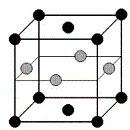Department of Physics and Astronomy: Publications and Other Research

Ralph Skomski Publications
Document Type
Article
Date of this Version
2013
Citation
IEEE TRANSACTIONS ON MAGNETICS, VOL. 49, NO. 10, OCTOBER 2013; DOI: 10.1109/TMAG.2013.2261821
Abstract
First-principle supercell calculations are used to determine how 3d elemental additions, especially Fe additions,modify the magnetization, exchange and anisotropy of L10-ordered ferromagnets. Calculations are performed using the VASP code and partially involve configurational averaging over site disorder. Three isostructural systems are investigated: Fe-Co-Pt,Mn-Al-Fe, and transition metal-doped Fe-Ni. In all three systems the iron strongly influences the magnetic properties of these compounds, but the specific effect depends on the host. In CoPt(Fe) iron enhances the magnetization, with subtle changes in the magnetic moments that depend on the distribution of the Fe and Co atoms. The addition of Fe to MnAl is detrimental to the magnetization, because it creates antiferromagnetic exchange interactions, but it enhances the magnetic anisotropy. The replacement of 50% of Mn by Fe in MnFeAl2 enhances the anisotropy from 1.77 to 2.5 MJ/m3. Further, the substitution of light 3d elements such as Ti, V, Cr into L10-ordered FeNi is shown to substantially reduce the magnetization.


Comments
Copyright 2013 IEEE. Used by permission.